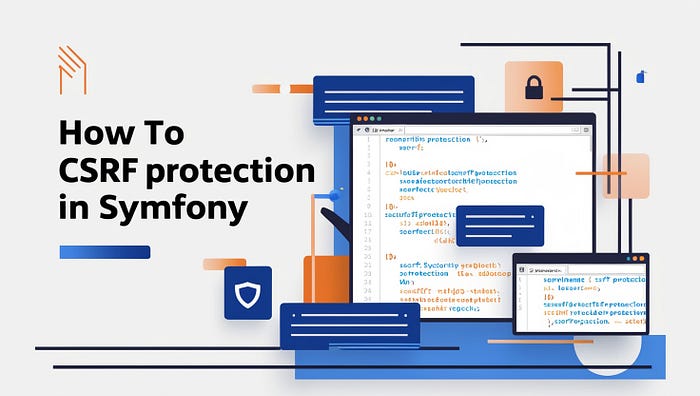How to Implement CSRF Protection in Symfony with Example

Implementing Cross-Site Request Forgery (CSRF) protection in Symfony is crucial for any web application to prevent unauthorized actions performed on behalf of authenticated users.
Here’s a comprehensive guide covering what CSRF attacks are, how to implement CSRF protection in Symfony, and an example of putting it into practice.
Table of Contents
1. Introduction to CSRF Attacks
∘ What is CSRF?
∘ How Does a CSRF Attack Work?
∘ Why is CSRF Protection Important?
2. CSRF Protection Mechanisms in Symfony
∘ How Symfony Protects Against CSRF
∘ Using the CSRF Token Manager
∘ Configuring CSRF Protection in Symfony Forms
3. Setting up CSRF Protection in Symfony
∘ CSRF Configuration in Symfony Forms
∘ Protecting Non-Form Actions
∘ Customizing CSRF Tokens
4. Implementing CSRF Protection: Step-by-Step Example
∘ Project Setup
5. Advanced CSRF Protection Techniques in Symfony
∘ Customizing Token Lifetime
∘ Token Rotation Strategies
∘ CSRF Protection in APIs
6. Testing and Verifying CSRF Protection
7. Advanced CSRF Management in Symfony
∘ Customizing the CSRF Token Manager
∘ Handling Token Expiry
∘ CSRF Protection with Stateless APIs
8. Debugging CSRF Issues
∘ Common CSRF Issues and Solutions
9. Testing and Securing Your CSRF Protection
∘ Testing Techniques
11. Common Questions and Best Practices
∘ Should I Enable CSRF Protection on All Forms?
∘ How Often Should CSRF Tokens Be Rotated?
∘ Is CSRF Protection Necessary for AJAX Requests?
1. Introduction to CSRF Attacks
What is CSRF?
Cross-Site Request Forgery (CSRF) is a type of web attack where a malicious site tricks a user’s browser into making an unwanted request to a different site where the user is authenticated.
This can lead to unauthorized actions like changing account information, making purchases, or even deleting data.
How Does a CSRF Attack Work?
CSRF attacks exploit the trust that a web application has for a user’s browser.
Here’s a basic flow:
- The user logs into a trusted site (e.g.,
example.com) and obtains a session cookie. - The user unknowingly visits a malicious site, which has hidden forms or scripts.
- These scripts make requests to
example.comusing the user’s session, which is still valid. - If
example.comlacks CSRF protection, the attack succeeds, and the action is performed on behalf of the user.
Why is CSRF Protection Important?
- Protecting against CSRF attacks is essential to secure the integrity of user actions and ensure that the application only processes authorized requests.
- Without CSRF protection, any authenticated session could be used by malicious actors to perform unauthorized actions.
2. CSRF Protection Mechanisms in Symfony
Symfony offers built-in tools to handle CSRF protection.
By default, Symfony forms come with CSRF protection enabled.
How Symfony Protects Against CSRF
Symfony leverages CSRF tokens, which are unique identifiers that accompany sensitive requests. Here’s how they work:
- Token Generation: For every form, Symfony generates a CSRF token.
- Token Validation: When the form is submitted, Symfony validates the CSRF token before processing the request.
Using the CSRF Token Manager
Symfony’s CsrfTokenManagerInterface handles generating and validating tokens. It provides methods to:
- Generate a token based on a given identifier.
- Validate tokens based on a submitted value and identifier.
Configuring CSRF Protection in Symfony Forms
Symfony’s form builder enables CSRF protection by default. Each form submission includes a hidden CSRF token, which Symfony verifies upon submission. If the token is invalid, Symfony will reject the request.
3. Setting up CSRF Protection in Symfony
CSRF Configuration in Symfony Forms
To ensure CSRF protection is applied to forms in Symfony:
- Enable it through the
csrf_protectionoption in your form types. - Define a token ID that uniquely identifies the form.
For instance:
use Symfony\Component\Form\AbstractType;
use Symfony\Component\Form\FormBuilderInterface;
use Symfony\Component\OptionsResolver\OptionsResolver;
class UserType extends AbstractType
{
public function buildForm(FormBuilderInterface $builder, array $options)
{
$builder
->add('username')
->add('email')
->add('submit', SubmitType::class);
}
public function configureOptions(OptionsResolver $resolver)
{
$resolver->setDefaults([
'csrf_protection' => true,
'csrf_field_name' => '_token',
'csrf_token_id' => 'user_item',
]);
}
}Here:
csrf_protection: Enables CSRF protection.csrf_field_name: Sets the hidden field’s name containing the token.csrf_token_id: Unique ID for the form.
Protecting Non-Form Actions
For actions not involving forms, you can generate and validate CSRF tokens manually using the CsrfTokenManagerInterface.
Example:
use Symfony\Component\Security\Csrf\CsrfTokenManagerInterface;
public function deleteAction(Request $request, CsrfTokenManagerInterface $csrfTokenManager)
{
$csrfToken = $request->get('_token');
if (!$csrfTokenManager->isTokenValid(new CsrfToken('delete_item', $csrfToken))) {
throw new InvalidCsrfTokenException('Invalid CSRF token');
}
// Proceed with delete action
}Customizing CSRF Tokens
Symfony allows customizing tokens, such as setting specific token IDs for different forms or actions, to ensure granular protection.
4. Implementing CSRF Protection: Step-by-Step Example
Project Setup
For this example, assume you have a Symfony project set up with the default configurations.
- Install Symfony: Make sure Symfony and the CSRF component are installed:
composer require symfony/security-csrf2. Create a Secure Form: We’ll create a simple form for updating user profiles.
// src/Form/ProfileType.php
namespace App\Form;
use Symfony\Component\Form\AbstractType;
use Symfony\Component\Form\FormBuilderInterface;
use Symfony\Component\OptionsResolver\OptionsResolver;
class ProfileType extends AbstractType
{
public function buildForm(FormBuilderInterface $builder, array $options)
{
$builder
->add('name')
->add('email')
->add('submit', SubmitType::class);
}
public function configureOptions(OptionsResolver $resolver)
{
$resolver->setDefaults([
'csrf_protection' => true,
'csrf_field_name' => '_token',
'csrf_token_id' => 'profile_item',
]);
}
}3. Enable CSRF in the Controller: In your controller, render and validate the form.
// src/Controller/ProfileController.php
namespace App\Controller;
use App\Form\ProfileType;
use Symfony\Bundle\FrameworkBundle\Controller\AbstractController;
use Symfony\Component\HttpFoundation\Request;
use Symfony\Component\Security\Csrf\CsrfTokenManagerInterface;
class ProfileController extends AbstractController
{
public function editProfile(Request $request, CsrfTokenManagerInterface $csrfTokenManager)
{
$form = $this->createForm(ProfileType::class);
$form->handleRequest($request);
if ($form->isSubmitted() && $form->isValid()) {
// Handle form data
return $this->redirectToRoute('profile_success');
}
return $this->render('profile/edit.html.twig', [
'form' => $form->createView(),
]);
}
}4. Testing CSRF Tokens: Submit the form, and Symfony will automatically handle CSRF validation. If the token is invalid, the form will be rejected.
5. Advanced CSRF Protection Techniques in Symfony
Customizing Token Lifetime
- The default token lifetime is the session duration. You can implement short-lived tokens for sensitive actions by creating tokens on-demand and verifying them upon submission.
Token Rotation Strategies
- Implement a rotation strategy to ensure tokens are invalidated after use or after a certain time, reducing the risk of token reuse in attacks.
CSRF Protection in APIs
- For APIs, use CSRF tokens in combination with other protection mechanisms like API keys or OAuth.
6. Testing and Verifying CSRF Protection
Testing CSRF involves verifying:
- Token Generation: Ensure tokens are generated for every form.
- Token Validation: Confirm tokens are validated on submission.
- Error Handling: Attempt to submit requests with invalid tokens and confirm they are rejected.
7. Advanced CSRF Management in Symfony
In real-world applications, customizing token behavior and handling more complex security requirements may be necessary.
Here, we’ll look into advanced techniques for managing CSRF tokens.
Customizing the CSRF Token Manager
- Symfony’s
CsrfTokenManageris a flexible component that allows you to extend or customize its functionality. - By default, Symfony uses a session-based CSRF token, which is suitable for most use cases.
- However, in cases where your application requires custom token storage, you can extend the token manager.
For example, if you’re working with a stateless application (like APIs) or need to store tokens in a database, you can create a custom implementation by extending CsrfTokenManagerInterface.
// src/Security/CustomCsrfTokenManager.php
namespace App\Security;
use Symfony\Component\Security\Csrf\CsrfToken;
use Symfony\Component\Security\Csrf\CsrfTokenManagerInterface;
class CustomCsrfTokenManager implements CsrfTokenManagerInterface
{
public function getToken($tokenId): CsrfToken
{
// Custom logic to retrieve token from database or other storage
}
public function refreshToken($tokenId): CsrfToken
{
// Custom logic to create and persist a new token
}
public function removeToken($tokenId): ?CsrfToken
{
// Custom logic to invalidate a token
}
public function isTokenValid(CsrfToken $token): bool
{
// Custom logic to validate the token
}
}Then, configure Symfony to use your custom token manager by registering it as a service.
Handling Token Expiry
In scenarios where you want tokens to expire after a specific time, you can set expiration policies by storing tokens with timestamps in a database.
For instance, a custom token manager could check the token’s creation time against the current time before validating.
Here’s a brief example:
public function isTokenValid(CsrfToken $token): bool
{
$storedToken = $this->retrieveTokenFromDatabase($token->getId());
if (!$storedToken) {
return false;
}
$expiryTime = new \DateTime($storedToken['created_at']);
$expiryTime->modify('+15 minutes');
return $storedToken['value'] === $token->getValue() && $expiryTime > new \DateTime();
}In this example, the token will only be valid for 15 minutes after its creation, which can be helpful for securing sensitive actions like financial transactions or account changes.
CSRF Protection with Stateless APIs
When working with stateless applications (such as RESTful APIs), traditional session-based CSRF protection is not effective.
Instead, you can combine CSRF tokens with access tokens or other forms of authentication. One common approach is to:
- Generate a CSRF token server-side.
- Include the token in a response header.
- Require clients to include the token in requests as an HTTP header or parameter.
Here’s an example of adding CSRF protection to an API controller in Symfony:
// src/Controller/ApiController.php
namespace App\Controller;
use Symfony\Bundle\FrameworkBundle\Controller\AbstractController;
use Symfony\Component\HttpFoundation\JsonResponse;
use Symfony\Component\HttpFoundation\Request;
use Symfony\Component\Security\Csrf\CsrfTokenManagerInterface;
class ApiController extends AbstractController
{
public function secureAction(Request $request, CsrfTokenManagerInterface $csrfTokenManager)
{
$csrfToken = $request->headers->get('X-CSRF-Token');
if (!$csrfTokenManager->isTokenValid(new CsrfToken('api_action', $csrfToken))) {
return new JsonResponse(['error' => 'Invalid CSRF token'], 403);
}
// Process the request
return new JsonResponse(['status' => 'success']);
}
}8. Debugging CSRF Issues
Implementing CSRF protection can occasionally result in issues, especially if tokens are not properly generated or validated. Here are some common issues and solutions:
Common CSRF Issues and Solutions
Issue: CSRF Token is Invalid Error
Solution: Ensure the token is being correctly generated and passed in the form. Confirm the csrf_token_id matches between the form and validation logic. Also, verify that session storage is working as expected, as Symfony’s default CSRF implementation relies on session persistence.
Issue: Form Submissions Failing in Production
Solution: If your CSRF tokens work in a development environment but fail in production, check your caching configurations. Ensure that session configurations allow for CSRF tokens to persist correctly. Issues can arise if multiple servers are handling sessions inconsistently.
Issue: Custom CSRF Token Manager Not Working
Solution: If you have implemented a custom token manager and are experiencing issues, check the configuration to ensure your custom manager is correctly registered as a service. Also, validate that your custom manager adheres to the CsrfTokenManagerInterface.
9. Testing and Securing Your CSRF Protection
Testing CSRF protection is critical to ensure security measures are effective.
Here are some testing techniques and best practices:
Testing Techniques
- Manual Testing: Attempt to submit a form with an invalid or missing CSRF token. Ensure that the form submission is rejected, and any unauthorized actions are prevented.
- Automated Testing: Use PHPUnit and Symfony’s WebTestCase to simulate form submissions with both valid and invalid CSRF tokens. This is especially useful for regression testing.
Example:
// tests/Controller/ProfileControllerTest.php
namespace App\Tests\Controller;
use Symfony\Bundle\FrameworkBundle\Test\WebTestCase;
class ProfileControllerTest extends WebTestCase
{
public function testInvalidCsrfToken()
{
$client = static::createClient();
$client->request('POST', '/profile/edit', [
'_token' => 'invalid_token'
]);
$this->assertResponseStatusCodeSame(403);
}
}3. Security Audits: Use security auditing tools or third-party services like OWASP ZAP or Burp Suite to test for CSRF vulnerabilities.
11. Common Questions and Best Practices
Here are some frequently asked questions and best practices related to CSRF protection in Symfony:
1. Should I Enable CSRF Protection on All Forms?
Yes, enable CSRF protection on all forms that modify server-side data. Forms that are solely for searching or retrieving data do not typically require CSRF protection, as they do not change state.
2. How Often Should CSRF Tokens Be Rotated?
Tokens should ideally be unique per form submission. For highly sensitive forms, implement a short token lifespan to limit exposure if the token is intercepted.
3. Is CSRF Protection Necessary for AJAX Requests?
Yes, CSRF protection is essential for AJAX requests that change server state. Pass the CSRF token in the request header or payload, and validate it server-side.
More Topics on Symfony
Thank you for reading until the end. Before you go 🙋♂️:
📍 Be sure to clap and follow the writer ️👏️️
🔔 Follow me: https://medium.com/@mayurkoshti12
